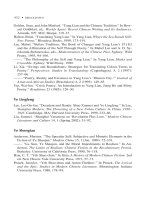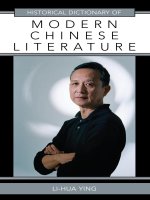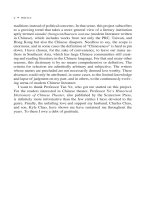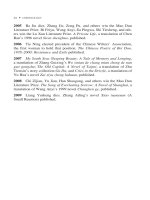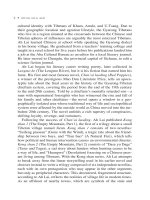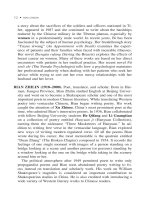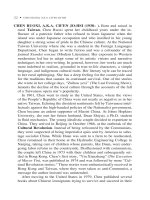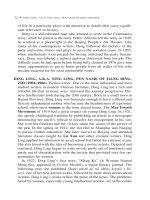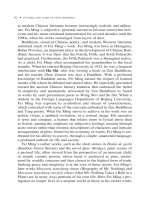"Historical Dictionary of Modern Chinese Literature" by Li-hua Ying - Part 6 ppt
Bạn đang xem bản rút gọn của tài liệu. Xem và tải ngay bản đầy đủ của tài liệu tại đây (91.63 KB, 10 trang )
CHEN RUOXI, A.K.A. CH’EN JO-HSI (1938– ). Born and raised in
rural Taiwan, Chen Ruoxi spent her childhood years under the in-
fluence of a patriotic father who refused to learn Japanese when the
island was under Japanese occupation and who instilled in his young
daughter a strong sense of pride in the Chinese culture. At the National
Taiwan University where she was a student in the Foreign Languages
Department, Chen began to write fiction and was a cofounder of the
journal Xiandai wenxue (Modern Literature). Her exposure to Western
modernism led her to adopt some of its artistic visions and narrative
techniques in her own writing. In general, however, her works are much
more indebted to realism, grounded in true-to-life characters, a simple
language, and indigenous cultural traits. Her literary style can be traced
to her rural upbringing. She has a deep feeling for the countryside and
for the traditions that sustain its continued survival. One of the stories
she wrote in her college days, “Zuihou yexi” (The Last Evening Show),
laments the decline of the local culture through the accounts of the fall
of a Taiwanese opera star’s popularity.
In 1961, Chen went to study in the United States, where the views
of the People’s Republic of China were not nearly as negative as in her
native Taiwan. Echoing the dissident sentiments felt by Taiwanese intel-
lectuals against the high-handed policies of the Nationalist government,
Chen became an ardent supporter of Maoist China. At Johns Hopkins
University, she met her future husband, Duan Shiyao, a Ph.D. student
in fluid mechanics. The young idealistic couple decided to expatriate to
China. They arrived in Beijing in October 1966, at the outbreak of the
Cultural Revolution. Instead of being welcomed by the Communists,
they were suspected of being imperialist spies sent by America to sabo-
tage socialist China. While Duan was sent to a farm to be reeducated,
Chen remained in their home at the Hydraulic Engineering College in
Nanjing, taking care of children whose parents, like Duan, were under-
going labor reform in the countryside. Disillusioned with communism,
the couple left China in 1973 with their children and subsequently set-
tled in Hong Kong. Chen’s first story, “Yin Xianzhang” (The Execution
of Mayor Yin), was published in 1974 and was followed by more “Cul-
tural Revolution stories.” These stories were enthusiastically received in
Hong Kong and Taiwan, where they were taken as anti-Communist, a
message the author insisted was unintended.
After moving to the United States in 1979, Chen published several
books about Chinese immigrants trying to survive and succeed in their
22 • CHEN RUOXI, A.K.A. CH’EN JO-HSI
new country. Notable among them are Zhi hun (Marriage on Paper),
which relates how a phony marriage between a woman from Shanghai
and an American man turns into a true and caring partnership, Tuwei
(Breakout) about the problems faced by well-eduated Chinese im-
migrants in San Francisco, Yuanjian (Foresight), which describes the
pursuit of the American dream and its heavy toll on the individuals and
their families, and Er Hu (Two Men Named Hu), which portrays two
Chinese American couples. In 1995, Chen returned to her native Tai-
wan. Inspired by the charitable work done by Buddhist women there,
Chen wrote Hui xin lian (The Lotus of Kindness), depicting the journey
of three nuns from one family.
CHEN YINGZHEN, A.K.A. CH’EN YING-CHEN, PEN NAME OF
CHEN YONGSHAN (1937– ). Fiction writer. Chen Yingzhen attended
Tamkang University and graduated from the National Taiwan Univer-
sity. He began his literary career in 1959 and has published mostly short
stories portraying life in small villages and towns of Taiwan. In 1968,
Chen, accused of “pro-communist activities,” was found guilty and sen-
tenced to seven years in prison.
As a literary figure, Chen is a leading voice in the nativist literary
movement in Taiwan. Going against the modernist trend promoted by
his professors and fellow students at the Foreign Languages Department
of the National Taiwan University, Chen chose to adhere to the realist
tradition by writing about the harsh realities of rural poverty. Treating
literature as an outlet of social and moral conviction, Chen depicts the
sufferings and alienation of Taiwanese farmers who are forced into in-
solvency by encroaching modernization and an unscrupulous business
class. Chen also takes jabs at Taiwan’s attempt to Americanize and the
devastating effect it has on local culture. “Jiangjun zu” (Generals), one
of his best-known stories, about a local drum and gong band that plays
at funerals, laments the loss of a close-knit, traditional community in
industrializing Taiwan. In Chen’s writings, there is often the opposition
between idealism and materialism. A politically engaged writer, Chen
is often believed to have represented the social conscience of Taiwan
during the repressive reign of Chiang Kai-shek.
CHEN ZHONGSHI (1942– ). Fiction and prose writer. Fame came to
Chen Zhongshi late in life. Prior to the publication of Bai lu yuan (The
White Deer Plain), which won the Mao Dun Literature Prize, he was an
obscure writer leading a quiet life in Xi’an in northwestern China. The
CHEN ZHONGSHI • 23
novel changed his career almost overnight. Noted for its stylistic clarity
and memorable characters, the novel addresses the issue of morality in
Chinese society, particularly the role Confucianism plays in rural com-
munities. In the view of the May Fourth generation, Confucianism was
seen as the culprit responsible for China’s decline; it was blamed for
having emasculated the Chinese nation, turning it into “the sick man of
the Orient.” This verdict held sway decades after the May Fourth Move-
ment. It is no surprise that when the root-seekers began their search
for cultural heritage in the 1980s, they opted to overlook this most im-
portant tradition. Chen set out to rectify the situation. In Bai lu yuan, a
novel about the sweeping changes taking place in northwestern China’s
countryside during the 20th century, Chen attributes the disintegration
of social order to the abandonment of Confucian values. In his effort to
reevaluate the role Confucianism plays in Chinese society, Chen pres-
ents the ancient teaching as a positive force in building and maintaining
social stability and in serving as an indispensable moral compass. In ad-
dition to Bai lu yuan, Chen has written many short stories and essays.
CHENG FANGWU (1897–1984). Poet, fiction writer, and playwright.
One of the founders of the Creation Society, Cheng Fangwu spent
his formative years (1910–1921) in Japan, where he teamed with
Guo Moruo, Yu Dafu, and other Chinese students to promote radical
changes in China’s political, social, and literary institutions. After he
returned to China, Cheng moved to Guangzhou, the center of politi-
cal activities at the time, and taught at Guangdong University and the
Huangpu Military Academy. In 1927, after the alliance between the Na-
tionalists and the Communists fell apart, Cheng fled to Paris, where he
joined the Chinese Communist Party (CCP) and became the editor for
Chi guang (Red Light), an internal magazine published by the party’s
Berlin and Paris branches. Upon his return to China in 1931, Cheng
was assigned to key posts within the CCP, including party secretary of
Hong’an County, director of the Central Party School, and president of
United University of Northern China. After 1949, Cheng worked exclu-
sively in higher education, serving as a university president.
Cheng’s literary career was rather short, with a small output of writ-
ings mostly published in the 1920s when he was actively involved in
the Creation Society. He wrote short stories and poems, promoting a
“revolutionary literature” with the explicit purpose of effecting politi-
cal and social change. Later when he was working in the Communist
24 • CHENG FANGWU
headquarters in northern Shaanxi, he wrote plays and songs to boost
morale in service to the Communist cause. In his last years, he published
memoirs about his revolutionary career such as Changzheng huiyi lu (A
Memoir of the Long March), adding to the long list of personal accounts
written by veteran Communists about this important chapter in the CCP
history. More influential than his creative works are his commentaries
and critical essays, which represent the mainstream Marxist tradition of
the Chinese literary establishment. See also LEFT-WING ASSOCIA-
TION OF CHINESE WRITERS; SPOKEN DRAMA.
CHENG NAISHAN (1946– ). Novelist. Born in Shanghai, Cheng
Naishan moved to Hong Kong with her family in 1949, but returned
to her birthplace in 1956. She graduated from the Shanghai College
of Education and taught English at a high school for 10 years before
moving back to Hong Kong in the 1990s. Cheng’s literary career is
closely tied to Shanghai, which provides material and inspiration for
her works. Many of her writings about the city deal with wealthy
families, similar to her own, who remained in the city after the Com-
munist victory. A member of this once privileged class, Cheng knows
intimately how they have fared throughout the decades of political
vicissitudes. Lan wu (The Blue House) focuses on the family of the
former owner of Shanghai’s largest steel mill and how their lives
change in the aftermath of the revolution. Along the same line, Cheng
planned to write a trilogy about an influential business tycoon and his
descendents. The first book, Jinrongjia (The Banker), published in
1993 and based on her own grandfather’s life,
is set against the back-
ground of the Sino-Japanese War (1937–1945) during which the
protagonist tries to avert a financial disaster by maneuvering among
his business rivals, the puppet Chinese government, and the Japanese
occupiers. The novel also introduces the banker’s five children, set-
ting the stage for the events that will unfold in the sequels.
A recurring theme in Cheng’s works is the clash of social classes.
In Tiaoqin shi (The Piano Tuner), Cheng tells about the relationship
between the son of a piano tuner and the daughter of a former capitalist
who find themselves separated by an invisible wall despite their physi-
cal proximity. Her most recent work, Shanghai tange (Shanghai Tango),
recounts the glorious days of old Shanghai with its vibrant commercial
culture revolving around clubs, bars, cafés, sumptuous banquets, horse
races, and other grand entertainment.
CHENG NAISHAN • 25
CHI LI (1957– ). Novelist. A popular writer whose works deal with daily
lives of Chinese urbanites, Chi Li lives in Wuhan in central China and
writes about the city and its residents. Her works are realistic portray-
als of life in China today, addressing issues such as love and marriage,
jobs, housing, children’s education, food, sickness, and so on. Her style
is simple and straightforward. Among her publications are Butan aiqing
(Apart from Love) and Kouhong (Lipstick).
CHI ZIJIAN (1964– ). Fiction writer. Chi Zijian is native to China’s north-
east, which she considers “the soul” of her creative imagination. Since
she published her first story in the mid-1980s, Chi has produced several
collections of stories and essays and a number of novels. Growing up
in the remote mountainous region of Heilongjiang, Chi prefers quiet,
simple country living to the thrill of urban life, a sentiment reflected in
her writings. She writes in a plain but sensual language, telling stories
based on her observations of life around her, particularly the folklores
and customs of her hometown. She appreciates the small pleasures of
what nature has to offer. Like a poet, she picks out the imperceptible
bits and pieces of life and turns them into aesthetic moments. Because
of the pronounced features of sentimentality, intimacy, melancholy, and
nostalgia, Chi’s stories often read like romantic poems. Even her novels
bear characteristics of lyrical poetry; Mangmang qiancheng (Uncertain
Prospects) and Chen zhong xiangche huanghun (Morning Bells Ring
through Dusk) are some examples.
Wei Manzhouguo (The Puppet State of Manchuria), on the other
hand, marks a radical departure from her previous endeavors. Instead of
the usual concern over the individual life in contemporary rural north-
east, Chi turns her attention to an important period in the region’s and
the nation’s history. The book does not directly treat the armed resis-
tance against the Japanese during World War II, but deals with the daily
lives of the characters, from historical figures such as Emperor Puyi and
guerrilla general Yang Jingyu to fictional characters who represent the
ordinary folks who had to carry on with their lives under the Japanese
occupation. The novel also contains references to regional customs
such as the drum dance and the river lantern festival. Another ambitious
novel, E’erguna He you an (On the Right Bank of the Argun River), an
epic story narrated in the voice of a 90-year-old woman, the head of an
Oroqen tribe living at the Sino-Russian border, is about the century-old
history of how a traditional community tried to survive and maintain
26 • CHI LI
its lifestyle and human spirit under the pressure of outside forces. Ch-
uanyue yunceng de qinglang (Sunshine Through Clouds), told from the
perspective of a dog, is one of her rare acts of experimentation with a
different form of narration. See also WOMEN.
CIVIL WAR (1945–1949). The ideological split between the Kuomin-
tang (KMT), also known as the Nationalist Party, and the Chinese Com-
munist Party (CCP) went back to 1927, when their cooperation during
the Northern Expedition, whose purpose was to defeat the northern war-
lords and unify China, proved to be short-lived. Sensing the danger of
the Communist influence within the ranks of his army, General Chiang
Kai-shek broke away from the alliance and began a campaign to purge
the CCP members and the leftists within the KMT. Afterward, the two
parties fought intermittently, with the weaker CCP driven underground
in urban areas and to the countryside to fight guerrilla wars. When the
Sino-Japanese War broke out, the two sides formed an alliance for the
second time. After the Japanese surrender, the confrontation between
the KMT and the CCP resumed in a full-scale war. Fueled by a growing
discontent in the nation about rampant government corruption and hyper-
inflation, the CCP, now better armed and with bases in rural China more
consolidated, won the Civil War and gained control of the mainland (plus
Hainan Island), while the KMT managed to retain the territories of the
island of Taiwan, the Pescadores (Penghu), and several small islands off
the coast of Fujian. To this day, the two sides remain divided.
The impact of the Civil War on modern Chinese literature was pro-
found, not in the sense that the war was a subject matter for Chinese lit-
erature but that the ideological and political split between the National-
ists and Communists allowed Chinese literature written from the 1950s
to the 1970s to have a freer and less controlled development in Taiwan,
particularly with the modernist experiments, while the mainland pre-
occupied itself with ideological writings guided by the principles of
socialist realism.
CREATION SOCIETY (CHUANGZAO SHE). Founded in 1921, the
Creation Society was an influential literary organization. Its members
included Guo Moruo, Yu Dafu, and other prominent names. In its early
stage, it endorsed authentic expression with an emphasis on subjective,
personal, and romantic sentiments. After 1925, as the Communist ideol-
ogy gained popularity among Chinese intellectuals, the Creation Society
promoted a form of “revolutionary literature,” which influenced an entire
CREATION SOCIETY • 27
generation of writers and readers. When it was finally closed down by
the Nationalist government, many of its members joined the Left-wing
Association of Chinese Writers. See also CHENG FANGWU; FENG
NAICHAO; TIAN HAN; YANG HANSHENG; YE LINGFENG.
CRESCENT SOCIETY (XIN YUE PAI/SHE). Named after the journal,
Xin yue (Crescent), which published writings by liberal-minded intel-
lectuals, the Crescent Society represented an influential trend in 20th-
century intellectual development. In social thought, it embraced human-
istic and moderate reforms; in literature, it promoted modernist innova-
tions, epitomized by Xu Zhimo, whose Romantic poems transformed
Chinese poetry. All of its prominent members had been educated in
Great Britain and the United States and were professors at Beijing’s
major universities, including Hu Shi, Wen Yiduo, and Lin Huiyin.
Largely confined to academia, its influence began to diminish when Xin
yue ceased publication in 1933.
CULTURAL REVOLUTION (WENHUA DA GEMING), FULL
NAME: THE GREAT PROLETARIAN CULTURAL REVOLU-
TION (1966–1976). In the aftermath of his failed economic policies
of the Great Leap Forward in the late 1950s, Mao Zedong was forced
to stay on the political sidelines. Unsatisfied with the lost power and
uneasy about the “antisocialist” tendencies within the Chinese Com-
munist Party (CCP), Mao launched in the mid-1960s an offensive in
an attempt to “purify” the CCP and regain control of the state. Mao
believed that in a socialist society there always existed class struggle
and the possibility of the return of capitalism and imperialism; hence
the need for continuous revolutions. Mao’s theory sparked two different
interpretations within the party. The moderates perceived class struggle
to be in the lower stratums of society where the enemies were those al-
ready overthrown: the rich peasants, the counterrevolutionaries, and the
bourgeois intellectuals. The radical faction, on the other hand, wanted
to extend class struggle to the highest levels of the government and to
expose enemies among those still in power—the “capitalist roaders.” In
order to eliminate his political opponents, Mao sided with the radical
faction during the beginning years of the Cultural Revolution. The Red
Guards, all young students, were encouraged by the left-wing radicals
to bring down government authorities in Beijing and in the provinces,
which resulted in serious civil disorder, total collapse of the economy,
and massive destruction of cultural institutions.
28 • CRESCENT SOCIETY
The aborted coup mounted by Mao’s appointed successor, Lin
Biao, in September 1971, eroded the influences of the left-wing
radicals and led to the rehabilitation of disgraced former party lead-
ers, including Deng Xiaoping, who was reinstated as a vice premier
in April 1973. In 1976, three of the most senior party leaders passed
away: Premier Zhou Enlai in January, Zhu De (then chairman of the
Standing Committee of the National People’s Congress) in July, fol-
lowed by Mao Zedong in September. The country was also visited
by an unprecedented natural disaster in that year: an earthquake
devastated the city of Tangshan in Hebei Province, confirming the
popular Chinese belief that the “mandate of heaven” was withdrawn
from the rulers. In less than a month after Mao’s death, the radical
Gang of Four, led by Mao’s wife Jiang Qing, were arrested, bringing
the Cultural Revolution to an end. In 1981, the Central Committee
of the Chinese Communist Party officially condemned the Cultural
Revolution as a “serious national disaster launched and led by Mao
Zedong and exploited by Lin Biao and Jiang Qing and their counter-
revolutionary cliques.”
During the Cultural Revolution, literary activities nearly came to a
halt, with veteran writers thrown in the labor camps as in the case of
Ding Ling, tortured to death as happened to Zhao Shuli, driven to sui-
cide such as Lao She, or in most cases, forced to put down the pen due
to the harsh political atmosphere. Very few came out of it unscathed.
Those who managed to remain afloat were required to write politically
mandated works. The so-called proletarian art in the form of revolution-
ary model operas, produced under the direct guidance of Mao’s wife
Jiang Qing, influenced the literary field in a number of ways: works
were often created by a group of people and therefore bore no individual
authorship; radical ideological themes, particularly class struggle, and
larger-than-life heroes such as those portrayed in such novels as Ouyang
Hai zhi ge (The Song of Ouyang Hai) and Huanghai hong shao (The
Red Sentry of the Yellow Sea) were the only mode of expression. One
of the handful of writers who emerged during the Cultural Revolution
as standard-bearers of the era was Hao Ran, the most celebrated writer
at the time. His novels about class struggle and enlightened peasants in
the countryside were widely promoted by the authorities. Jinguang da
dao (The Golden Road), Yanyang tian (The Bright Clouds), and Xishao
ernü (Sons and Daughters of Xisha) were among the very few novels
allowed on the shelves of bookstores.
CULTURAL REVOLUTION • 29
When the Cultural Revolution ended, the serious damage it had done
to the country’s political and cultural institutions and the devastating
effects it had on the the Chinese national psyche have been extensively
explored in literature, first in the so-called scar literature represented
by Liu Xinwu, Lu Xinhua, and others, and later by writers exiled to
the Chinese frontier or labor camps, such as Wang Meng and Zhang
Xianliang, and most prominently by the large number of educated
youths sent to the countryside, such as Ah Cheng, Zhang Chengzhi,
Liang Xiaosheng, Han Shaogong, and Wang Xiaobo. See also BEI
DAO; CAN XUE; CHEN RUOXI; DENG YOUMEI; FENG JICAI;
GAO XIAOSHENG; GAO XINGJIAN; GU CHENG; GU HUA; HE
LIWEI; JING FU; KE YUNLU; LAO SHE; LI GUANGTIAN; LI-
ANG XIAOSHENG; LU WENFU; LU XING’ER; MANG KE; SHEN
RONG; SHIZHI; SU TONG; TIAN HAN; WANG ANYI; XIAO JUN;
YAN GELING; YAN LIANKE; YANG JIANG; YANG LIAN; YE
ZHAOYAN; YU HUA; ZHANG JIE; ZHANG KANGKANG; ZHENG
YI.
– D –
DAI WANGSHU (1905–1950). Poet. Born in Hangzhou, Dai Wangshu
studied literature and French in college and became one of the foremost
modern Chinese poets. His first poem “Ninglei chu men” (Leaving
Home in Tears) appeared in the inaugurating issue of Yinluo (A Jade
Necklace), a literary journal he founded with his friends. Dai spent three
years in France and was influenced by French symbolist poets, especially
Paul Verlaine, whose style appealed to Dai’s classical sensibilities. In
1929, his first collection of poetry, Wode jiyi (My Memories), was pub-
lished and one of the poems, “Yu xiang” (A Rainy Alley), became an
instant favorite among both critics and readers and remains one of the
beloved modern poems. Other works, such as “A Dream Seeker” and
“Bird of Paradise,” helped elevate Dai to the ranks of China’s leading
poets. Disillusionment and melancholy are signature themes of his early
poetry, expressed in a sentimental voice and a colloquial language inter-
spersed with rhythms commonly found in classical Chinese poetry.
A significant contributor to the development of modern vernacular
poetry, Dai showed an unwavering attention to form, which he consid-
ered to be the essence of poetry. He succeeded in creating a new poetic
30 • DAI WANGSHU
form that draws from both classical Chinese tradition and modern West-
ern styles such as those used by the English Romantics and the French
symbolists. He edited Xiandai shi feng (Modern Poetic Styles) and was
a founder of Xin shi (New Poetry), platforms for Chinese experimental
poetry and translations of Western works. Credited with introducing
many French writers to the Chinese public, he was also an avid reader
and translator of Spanish and Russian literature. Dai died of illness the
year after the People’s Republic of China was established. See also
MODERNISTS.
DENG YOUMEI (1931– ). Novelist. Though a veteran writer, Deng
Youmei did not come to prominence until the early 1980s when he
published a series of stories based on folklore and old traditions of
Beijing. “Huashuo Taoran Ting” (Talking about Taoranting Park),
Nawu (Nawu), Yan hu (Snuff Bottles), and “Xunzhao Hua’r Han”
(Looking for Han the Forger) are among his best-known works. The-
matically and aesthetically, these stories opened a new direction for
post-Mao literature. Instead of writing directly about the destructive
Cultural Revolution, a popular literary trend that was later given
the name scar literature, Deng found inspiration in the old customs
of Beijing formed by centuries of history as the political and cultural
capital of the country, and particularly through the Manchu influences
of the Qing dynasty. The main character in Nawu is a descendant of
Manchu nobility who is an expert in many things, from cockfights
and dog races to Peking opera and ancient art, everything except for
the basic skills that could help him make a living at the time. “Xun-
zhao Hua’r Han” portrays the vicissitudes in the life of an antiques
connoisseur. “Huashuo Taoran Ting” is set against the political
backdrop of the 1970s, but the focus is on four old men practicing tai
chi in the park. Deng makes good use of traditional institutions and
objects, such as theaters, old academies, antiques, paintings, and cal-
ligraphies through which his characters interact with one another to
form social connections. For his effort in searching for the old ways
of life characteristic of a specific locale, Deng is considered one of
the forerunners of the root-seeking movement in the post-Mao era.
He took as models classical Chinese literature and art, such as Hong
lou meng (A Dream of Red Mansions), Shuihu zhuan (The Water
Margin), and the painting “Qingming shanghe tu” (The Scene of the
Upper River at Qingming), which focus on presenting multiple facets
DENG YOUMEI • 31
